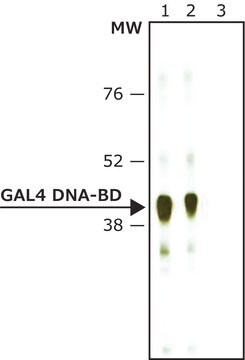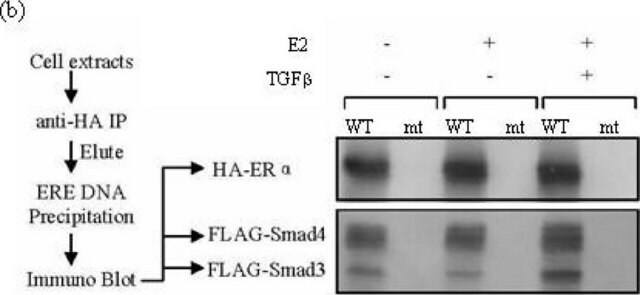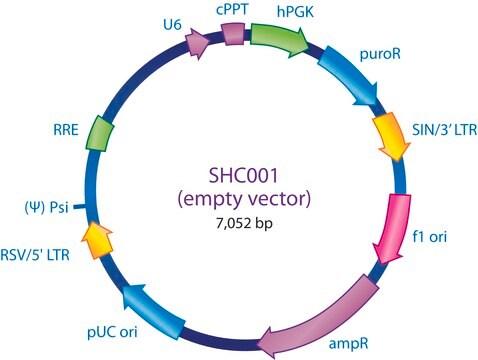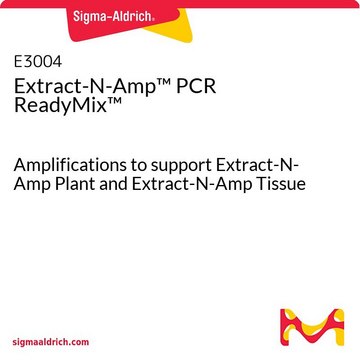Wszystkie zdjęcia(1)
Kluczowe dokumenty
G9293
Anti-GAL4, Activation domain antibody produced in rabbit
~1.0 mg/mL, affinity isolated antibody, buffered aqueous solution
Synonim(y):
Anti-Galactose 4
Zaloguj sięWyświetlanie cen organizacyjnych i kontraktowych
About This Item
Polecane produkty
pochodzenie biologiczne
rabbit
Poziom jakości
białko sprzężone
unconjugated
forma przeciwciała
affinity isolated antibody
rodzaj przeciwciała
primary antibodies
klon
polyclonal
Formularz
buffered aqueous solution
stężenie
~1.0 mg/mL
metody
western blot: 0.5 μg/mL using GAL4-AD fusion protein in Saccharomyces cerevisiae extract
Warunki transportu
dry ice
temp. przechowywania
−20°C
docelowa modyfikacja potranslacyjna
unmodified
Opis ogólny
GAL4 protein is an 881 amino acid transcription factor containing an independent N-terminal DNA binding (147 amino acids) and C-terminal activator domains. It is a regulatory gene that belongs to GAL gene family. It is a component of yeast two hybrid system, where GAL 4 DNA-BD is fused to protein X (bait) and GAL4 activation domain is fused to protein Y (prey).
Useful in the study of protein:protein interaction studies. GAL4 DNA activation domain fusion proteins.
Immunogen
Synthetic peptide corresponding to amino acids of Saccharomyces cerevisiae GAL4 protein.
Zastosowanie
Anti-GAL4, Activation domain antibody produced in rabbit has been used in western blotting.
Działania biochem./fizjol.
GAL4 induces the genes that are responsible for regulation of galactose metabolism in saccharomyces cerevisiae. GAL4 protein is widely used for studying transcriptional activation in eukaryotes. The yeast two hybrid system is widely used to study to discover protein− protein interactions (PPIs) and protein−DNA interactions.
Postać fizyczna
The product is provided as a solution of affinity isolated antibody in 0.01 M phosphate buffered saline, pH 7.4, containing 1% bovine serum albumin and 15 mM sodium azide as a preservative.
Przechowywanie i stabilność
For continuous use, store at 2-8 °C for up to one month. For extended storage, freeze in working aliquots. Repeated freezing and thawing is not recommended. Storage in “frost-free” freezers is not recommended. If slight turbidity occurs upon prolonged storage, clarify the solution by centrifugation before use. Working dilution samples should be discarded if not used within 12 hours.
Oświadczenie o zrzeczeniu się odpowiedzialności
Unless otherwise stated in our catalog, our products are intended for research use only and are not to be used for any other purpose, which includes but is not limited to, unauthorized commercial uses, in vitro diagnostic uses, ex vivo or in vivo therapeutic uses or any type of consumption or application to humans or animals.
Ta strona może zawierać tekst przetłumaczony maszynowo.
Nie możesz znaleźć właściwego produktu?
Wypróbuj nasz Narzędzie selektora produktów.
Kod klasy składowania
10 - Combustible liquids
Klasa zagrożenia wodnego (WGK)
WGK 3
Temperatura zapłonu (°F)
Not applicable
Temperatura zapłonu (°C)
Not applicable
Wybierz jedną z najnowszych wersji:
Masz już ten produkt?
Dokumenty związane z niedawno zakupionymi produktami zostały zamieszczone w Bibliotece dokumentów.
H Efsun Arda et al.
Molecular systems biology, 6, 367-367 (2010-05-13)
Gene regulatory networks (GRNs) provide insights into the mechanisms of differential gene expression at a systems level. GRNs that relate to metazoan development have been studied extensively. However, little is still known about the design principles, organization and functionality of
Guihong Tan et al.
Genetics, 183(1), 13-22 (2009-07-15)
Reversible and easy to use, temperature-sensitive (TS) mutations are powerful tools for studying gene function. However, TS alleles are rare and difficult to generate and identify, and this has limited their use in most multicellular organisms. We have generated and
Alessandro Berto et al.
EMBO reports, 19(5) (2018-04-11)
Cenp-F is a multifaceted protein implicated in cancer and developmental pathologies. The Cenp-F C-terminal region contains overlapping binding sites for numerous proteins that contribute to its functions throughout the cell cycle. Here, we focus on the nuclear pore protein Nup133
Nasz zespół naukowców ma doświadczenie we wszystkich obszarach badań, w tym w naukach przyrodniczych, materiałoznawstwie, syntezie chemicznej, chromatografii, analityce i wielu innych dziedzinach.
Skontaktuj się z zespołem ds. pomocy technicznej








